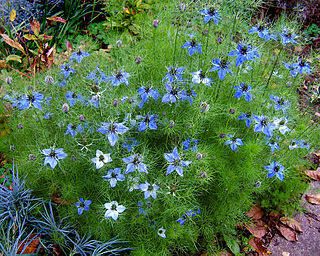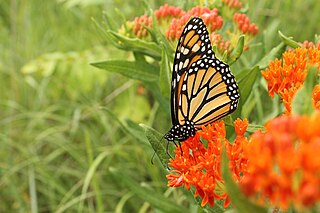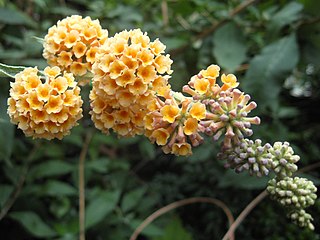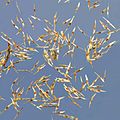
Buddleja is a genus comprising over 140 species of flowering plants endemic to Asia, Africa, and the Americas. The generic name bestowed by Linnaeus posthumously honoured the Reverend Adam Buddle (1662–1715), an English botanist and rector, at the suggestion of Dr. William Houstoun. Houstoun sent the first plants to become known to science as buddleja to England from the Caribbean about 15 years after Buddle's death. Buddleja species, especially Buddleja davidii and interspecific hybrids, are commonly known as butterfly bushes and are frequently cultivated as garden shrubs. Buddleja davidii has become an invasive species in both Europe and North America.

Armand David, CM was a Lazarist missionary Catholic priest as well as a zoologist and a botanist.

Pelargonium is a genus of flowering plants that includes about 280 species of perennials, succulents, and shrubs, commonly called geraniums, pelargoniums, or storksbills. Geranium is also the botanical name and common name of a separate genus of related plants, also known as cranesbills. Both genera belong to the family Geraniaceae. Carl Linnaeus originally included all the species in one genus, Geranium, and they were later separated into two genera by Charles Louis L'Héritier de Brutelle in 1789.

Nigella damascena, love-in-a-mist, or devil in the bush, is an annual garden flowering plant, belonging to the buttercup family Ranunculaceae. It is native to southern Europe, north Africa and southwest Asia, where it is found on neglected, damp patches of land.

Butterfly gardening is a way to create, improve, and maintain habitat for lepidopterans including butterflies, skippers, and moths. Butterflies have four distinct life stages—egg, larva, chrysalis, and adult. In order to support and sustain butterfly populations, an ideal butterfly garden contains habitat for each life stage.

Acer davidii, or Père David's maple, is a species of maple in the snakebark maple group. It is native to China, from Jiangsu south to Fujian and Guangdong, and west to southeastern Gansu and Yunnan.

The mullein moth is a noctuid moth with a Palearctic distribution. The species was first described by Carl Linnaeus in his landmark 1758 10th edition of Systema Naturae.

Buddleja crispa, the Himalayan butterfly bush, is a deciduous shrub native to Afghanistan, Bhutan, North India, Nepal, Pakistan and China, where it grows on dry river beds, slopes with boulders, exposed cliffs, and in thickets, at elevations of 1400–4300 m. Named by Bentham in 1835, B. crispa was introduced to cultivation in 1850, and came to be considered one of the more attractive species within the genus; it ranked 8th out of 57 species and cultivars in a public poll organized by the Center for Applied Nursery Research (CANR) at the University of Georgia, US. In the UK, B. crispa was accorded the Royal Horticultural Society's Award of Merit in 1961. However, the species is not entirely cold-hardy, and thus its popularity is not as ubiquitous as it might otherwise be.

Buddleja globosa, also known as the orange-ball-tree, orange ball buddleja, and matico, is a species of flowering plant endemic to Chile and Argentina, where it grows in dry and moist forest, from sea level to 2,000 m. The species was first described and named by Hope in 1782.

Clematis montana, the mountain clematis, also Himalayan clematis or anemone clematis, is a flowering plant in the buttercup family Ranunculaceae. A vigorous deciduous climber, in late spring it is covered with a mass of small blooms for a period of about four weeks. The odorous flowers are white or pink, four-petalled, with prominent yellow anthers. It is native to mountain areas of Asia from Afghanistan to Taiwan.

The white currant or whitecurrant is a group of cultivars of the red currant, a species of flowering plant in the family Grossulariaceae, native to Europe.

Buddleja fallowiana is a species of flowering plant in the figwort family Scrophulariaceae. It is endemic to the Yunnan province of western China, where it grows in open woodland, along forest edges and watercourses. The plant was collected in China by the Scottish botanist George Forrest in 1906, and named in 1917 by Balfour and Smith for George Fallow, a gardener at the Royal Botanic Garden Edinburgh. Fallow had died in Egypt in 1915 from wounds sustained fighting in the Gallipoli Campaign.

Coprosma repens is a species of flowering shrub or small tree of the genus Coprosma, in the family Rubiaceae, native to New Zealand. Common names include taupata, tree bedstraw, mirror bush, looking-glass bush, New Zealand laurel and shiny leaf.

Buddleja officinalis is a deciduous early-spring flowering shrub native to west Hubei, Sichuan, and Yunnan provinces in China. Discovered in 1875 by Pavel Piasetski, a surgeon in the Russian army, B. officinalis was named and described by Maximowicz in 1880. Introduced to western cultivation in 1908, B. officinalis was accorded the Royal Horticultural Society's Award of Merit three years later, and the Award of Garden Merit in 2002.

Buddleja forrestii is a deciduous shrub or small tree widely distributed from India to western China. First described by Diels in 1912, he named the species for plant hunter George Forrest, who discovered the plant in Yunnan in 1904 and introduced it to Western cultivation.

Buddleja madagascariensis, the smokebush or Madagascan butterfly bush, is a species of flowering plant in the figwort family Scrophulariaceae. It is a substantial evergreen shrub with fragrant yellow flowers through autumn and winter.

Buddleja × weyeriana is one of the more remarkable Buddleja hybrids, the first crossing of an Asiatic species with a South American. The hybrid was raised during the First World War by the eponymous Major William van de Weyer at his home, Smedmore House, at Corfe Castle, England. Van de Weyer was hoping to achieve an inflorescence the size of davidii with the colour of globosa, but met with only limited success.

Buddleja fallowianavar.albaSabourin is a white-flowered variety of B. fallowiana endemic to Yunnan in western China, where it grows in open woodland, along forest edges and watercourses. The shrub was considered superior to the lavender-blue flowered B. fallowiana by Bean, who thought it one of the most attractive of all buddlejas.
Buddleja davidiivar.wilsonii is endemic to western Hubei, China, at elevations of between 1600 and 2000 m; it was named for the English plant collector Ernest Wilson by Alfred Rehder. The taxonomy of the plant and the other five davidii varieties has been challenged in recent years. Leeuwenberg sank them all as synonyms, considering them to be within the natural variation of a species, a treatment adopted in the Flora of China published in 1996.

William John Bates van de Weyer was a British Militia officer who won lasting fame in horticulture as the first to hybridize a South American species of Buddleja with an Asiatic species while on leave during World War I.





























